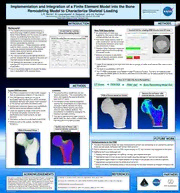
NASA Technical Reports Server (NTRS) 20170001542: Implementation and Integration of a Finite Element Model into the Bone Remodeling Model to Characterize Skeletal Loading PDF
Preview NASA Technical Reports Server (NTRS) 20170001542: Implementation and Integration of a Finite Element Model into the Bone Remodeling Model to Characterize Skeletal Loading
Implementation and Integration of a Finite Element Model into the Bone Remodeling Model to Characterize Skeletal Loading National Aeronautics and Space Administration C.R. Werner1, B. Lewandowski2, A. Boppana1, and J.A. Pennline2 1ZIN Technologies, 6745 Engle Road, Airport Executive Park, Cleveland, OH 44130 2NASA Glenn Research Center, Cleveland, Ohio INTRODUCTION METHODS Background • New FEM Description Current GUI for creating FEM directly from CT scan The Digital Astronaut project is developing a Current GUI for running • bone physiology model to predict changes in Bone Remodeling Model An anonymous CT scan was bone mineral density over the course of a space supplied by JSC and an FEM was mission, by predicting bone loss due to created directly from the scan exposure to a microgravity environment, and by • The Dicom image stack is made of predicting bone maintenance due to mechanical cubic voxels which can be converted stimulus generated by exercise to hexahedral elements using voxel countermeasures. These predictions will be size dimensions of 3mm used to inform exercise device efficacy as well • Phantom Tube Calibration values are as develop exercise protocols that maintain used to determine the bone density healthy bone mineral density during long of selected voxels duration spaceflight missions. • • Modulus of elasticity is calculated The mechanical stimulus sensed by the bone using ash density and bone volume and the stresses that are applied to the bone are fraction relationships [2] important factors for bone remodeling • The stresses are dependent on the type of • exercise and vary across the bone structure due Loads [3] are applied at the head and neck, but on groups of nodes which prevent the need to use a to geometry rigid element • • One of the primary regions of concern for bone The base is constrained in all 6 DOF • loss in spaceflight is the proximal femur. The CT FEM is generated using Matlab’s Image Processing Toolbox. The bone remodeling model also uses the Matlab platform, therefore, information from the FEM can be easily passed to the Bone Remodeling code. Flow of CT data into Bone Remodeling CT Dicom FEM GUI FEM “.dat” Bone Remodeling Model GUI METHODS Current FEM Description Limitations • • The FEM is created from a CAD model created The proximal femur model has only two Section Cut of Femur with from an anonymous subject’s CT hip scan [1] material properties. This oversimplifies the FEM of Femur based on Voxels material density contoured • femur and neglects the varying densities The CAD geometry allows for the use of seen from CT scans automated meshing algorithms which use linear • tetrahedral elements with higher mesh resolution The limitation of two material properties on the surface and within the femoral neck requires the consolidation of a single stress • value per material, because the Bone Cortical and trabecular regions were qualitatively Remodeling Model requires one stress defined using manual selection methods. value for each material modulus. The • Loads are applied as single nodes at the center consolidation is handled by averaging the of the head and greater trochanter and maximum principle stresses. distributed to the model surfaces via rigid • The use of rigid elements make it easy to elements define loads, but also creates unrealistically • The bottom surface is constrained for all 6 DOF high stresses at connecting nodes • While smooth on the outside, the FEM has limitations. Section Cut of Femur with material density contoured FEM of Proximal Femur (2 materials) FUTURE WORK Enhancements to the FEM • The Bone Remodeling Model has been restructured to perform the remodeling on an element by element basis, but still needs verification with former FEM versions • Due to calibration issues, the new FEM, based directly on CT, has not been fully integrated at this point. • Additional technical challenges are: • Appropriate load application for walking, running, and resistive exercises • Appropriate type of strain to use (current model assumes average of maximum principle stress) • Appropriate approximation or implementation of isotropic or anisotropic bone material properties • Appropriate averaging across the whole proximal femur • Ensure the Bone Remodeling Model is robust enough for the large variation of stresses throughout the bone ACKNOWLEDGEMENTS REFERENCES PARTNERS [1] Werner, C. & Gorla, R.S.R., 2013. Int J Appl Mech, 18(3), pp.911–921. This work is funded by the NASA Human Research Program, managed by the NASA Johnson Space Center. Specifically, this work is part of the [2] Chang, K.L. & Pennline, J.A., 2013. NASA/TM-2013-217842. Available online at: http://ntrs.nasa.gov Digital Astronaut Project (DAP), which directly supports the Human Health and Countermeasures (HHC) Element. The DAP project is managed out [3] Orthoload [http://www.orthoload.com/] of NASA/Glenn Research Center (GRC) by Kelly Gilkey and Beth Lewandowski serves as the DAP Project Scientist. Special thanks to [4] Hazelwood, S. & Castillo, A., 2007. Int J Fatigue, 29(6), pp.1057–1064. Omar Gad, who helped during his Pathways Internship in Summer 2016. printed by www.postersession.com www.nasa.gov
